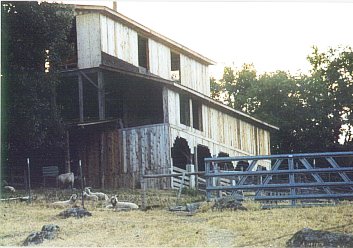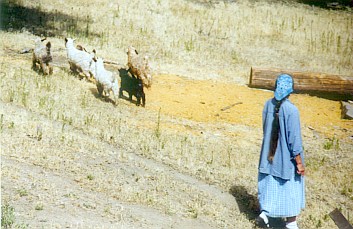~~* Black Sheep Newsletter............Issue 120............Summer 2004 *~~
 †
†
THE HOMESTEAD: SPONTANEOUS COMBUSTION AND HAY FIRES
Harold K. House, P. Eng., Dairy and Beef Structures and Equipment Specialist
Ontario Ministry °F Agriculture and Food - Clinton, Ontario. (July 1998)
Lives have been lost and hay crops destroyed because °F fires caused by spontaneous combustion. This year has been particularly bad for hay heating due to the hot humid weather. If the hay crop is put into the mow above 20-25% moisture content, spontaneous combustion may occur.
A hay crop that is placed too wet into a mow will heat rapidly. If the mow is so large that heat loss is restricted, the internal temperature will rise. As the temperature rises above 130 °F (55 °FC), a chemical reaction occurs and may sustain itself. This reaction does not require oxygen, but the flammable gases produced are at a temperature above their ignition point. These gases will ignite when they come in contact with the air.
Check your hay regularly. If you detect a slight caramel odour or a distinct musty smell, chances are your hay is heating.

The barn at Singing Falls
What do you do if you suspect that your hay is heating? First °F all, make yourself a simple probe that can be inserted into the hay mass to check the temperature. A probe can be made from a 10 foot piece °F electrical tubing. Rivet a hardwood pointed dowel to one end and drill 8 - 3/16 inch diameter holes in the tube just above the dowel. Drive the probe into the hay mass and lower a candy thermometer on a long string into the probe. The thermometer should be left for 10 minutes to ensure an accurate reading.
Watch for the following temperatures:
150 °F (65 °FC) ** ENTERING THE DANGER ZONE. Check temperature daily.
160 °F (70 °FC) ** DANGER! Measure temperature every four hours and inspect mow.
175 °F (80 °FC) ** CALL THE FIRE DEPARTMENT! Wet hay down and remove from the barn.
185 °F (85 °FC) ** HOT SPOTS AND POCKETS MAY BE EXPECTED. Flames will likely develop when heating hay comes in contact with the air.
212 °F (100 °FC) CRITICAL! Temperature rise is rapid above this point. Hay will almost certainly ignite.
CAUTION: Before entering the mow, place long planks on top °F the hay. Do not attempt to walk on the hay mass itself. Pockets may have already burned out under the hay surface. Always tie a rope around your waist and have a second person on the other end in a safe location to pull you out should the surface °F the hay collapse into a fire pocket.
Extreme caution should be taken when fighting a hay fire if hay has been treated with chemical preservatives. Hay treated with preservatives containing ethoxyquin and BHT (butylated hydroxytoluene) will produce hydrogen cyanide gas at around 240 °F (115 °FC). This gas is very deadly. Additives containing primarily propionic acid to not produce hydrogen cyanide during a fire.
Many farmers sprinkle salt on hay as it is stored, in an effort to prevent hay fires. However, tests have shown that salt has no effect on controlling spontaneous combustion. Dry ice, liquid nitrogen or carbon dioxide gas pumped into the hay will prevent combustion by eliminating the oxygen from the hay mass.
Spontaneous combustion is not an accident. By following good storage practices, not only will spontaneous combustion by avoided, but a higher quality °F hay will be obtained.
Goats and More Goats
May was our "birth month" for the most part. Approximately 25 new kid goats dropped on the ground during that busy month, and though a few popped out white as the driven snow, we were awed by our share °F color. One late May night the intercom signaled my light-sleeping husband that someone was in labor up there at the barn. I knew by my calendar at least three or four were soon due.![]()
"Why do they wait until now?" I asked my husband as we both dressed in regal barn attire for the trek upward the hillside to the barn. I pulled the rabbit angora cap snugly around my head and we both ventured outside, our barn coats tight around us. The stars were twinkling in a deep black sky above us, nature's cathedral filled with light.![]()
By the time we entered the barn, its sole electric light showed us a new kid had already been dropped. "Black as midnight," I heard my husband's s°Ft spoken words. Indeed, she was black as midnight. Diane had given birth, lovely white Diane whose dam is a registered white goat and whose sire was a nice silver buck. "So much face hair already that she's almost snow-blind!" Stan laughed. Indeed, she had a lot °F hair for a newborn kid!![]()
So, we doctored up Diane, made sure the kid was nursing, and trudged on home, happy at 11 pm. At 1:00 am, my sweet husband turned to me and said, "sounds like another out there ready to give birth." My sleep was being interrupted again, I noted. I also took quick mental note that tonight seemed to be a strange night in that all the goats had decided it was time to "let go" °F their cargo in the middle °F the night.![]()
So, we were up and dressing again as the sounds °F a laboring goat kept streaming through that intercom speaker. I said, "Might be Donna's Silver giving birth. She's about due. Or might be #87. She's due." I was a bit excited about both °F the gals, having bred them both to Dakota, a dark brown buck who seems to never fail to give color to his progeny.![]()
"Midnight black," I heard my husband say as he greeted the new mother, Donna's Silver. Indeed, she was midnight black. "And another girl," I added as I took the necessary time to find out what sex the newborn was. "Two nice doelings tonight, both black. Two nice additions to Singing Falls Mohair," I smiled over at my tired husband. We took out the iodine spray bottle, sprayed the navel. "They are both suckling just fine," I said. We trudged back to the warm house.![]()
At four in the morning was when #87 decided it was her time to give birth. Another girl. Another black girl. So, that starry starry May night held three wonderful surprises for us, intrepid goatherds that we are. Three nice surprises.![]()
Early this month, the day before the last day °F school, actually, a group °F kindergartners and first graders, 11 children in all from the local school drove up our drive in their shiny yellow school bus. The six or so adults that accompanied them were just as anxious to see all the angora goats on this goat farm. We took them up to the barn first, where they got to see all the rambunctious kid goats jumping from rock to rock, all bundles °F color. Their mothers, the does, stood patiently to the side watching the carnival.![]()
"Just how many goats do you have here?" asked one °F the adults, the bus driver, if I'm not mistaken. It was a decent question and one I should have expected, but it caught me °Ff guard.![]()

Alexandra with the herd
"I don't know," was my truthful answer. "I think about 70. Maybe 75." Finally I asked someone there to please count and tell me, because I certainly needed to know. They all laughed.![]()
We stood there together in the yard watching goats and watching children fascinated by tiny goats who ran from them as they carefully pursued their bounding forms. (All °F us then asked the children not to chase the goats, and they readily complied.) Whenever my husband scooped up a kid goat in his arms, the children huddled in closely so that they could "touch" all that s°Ft baby mohair and pet the small creature. The adults, too, reached forth their hands to pet the small goats. Everyone seemed fascinated by the little bundles °F mohair.![]()
"Colored mohair?" asked one lady incredulously. That was the kind °F question I had hoped to answer, and I told them all about colored angora goats, or as much as I thought they'd want to know.![]()
Our herd is very large these days - large and colorful! I still recall the days when we had 20 or so angora goats in our herd. Life was not as rushed then. I knew every name and no goat was named by the number stamped into its ear tag alone. If one black doeling was born in an entire birthing season, we felt fulfillment. Now we have three born in one night and call it good.![]()
Times change to be sure. It's been a very pr°Fitable spring. Summer is on the horizon. My spinning wheel and loom will be busy - with colored mohair.![]()
Alexandra Scribe
Homestead Home
TOP






